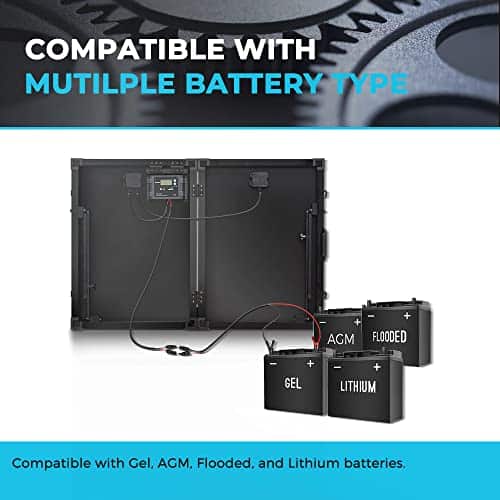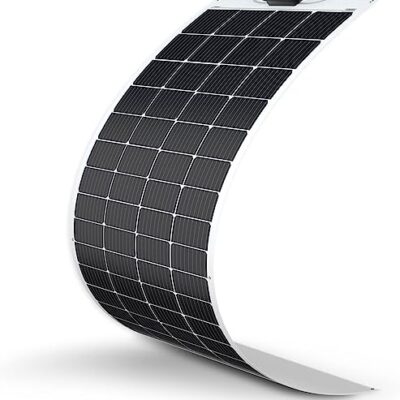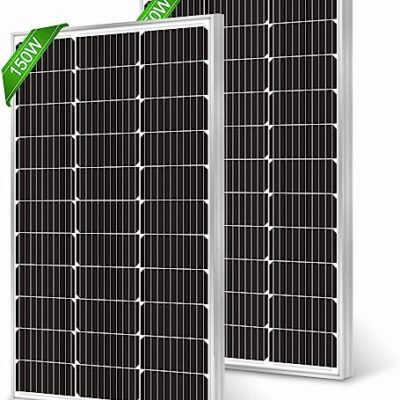Description
- 【Plug and play solar kit 】complete kit includes a 100W solar suitcase, a 20A waterproof charge controller, and alligator clips. Compatible with multiple kinds of 12V batteries, easily add to your existing system.
- 【Highly portable design】 foldable solar suitcase small in size, provide more flexibility for outdoor and off-grid use, easy to carry, store and set up.
- 【Remarkable efficiency】Renogy solar panels using grade A plus monocrystalline solar cells. Advanced smart PWM technology charge controllers ensure charging efficiency and safety.
- 【Reailable quality】coming with a premium rugged canvas protective case, heavy-duty handle, and latches for longevity.
- 【Safety guarantee】multiple protections provided by the charge controller keep your battery and system fully protected.










E.C.W. –
We used this set all last camping season. When the sun was out we could follow it most anywhere it went. Much of the time the 100 watt panel was putting more into the system than were the 380 watts worth of panels on our trailer’s roof. Can’t follow the sun with those!
Amazing how the slightest shadow across the panels will cut a great deal of wattage. Even a broom handle, which I tried, reduces it very noticeably. Having the ability to follow the sun made enough difference that we could stay out 2 to 3 days.
We had a 12 volt DC compressor fridge which had a voracious appetite for power that would run our 2 6-volt golf cart batteries into the dirt in just 2 days. We got 3 days with autumn sun when we upgraded to 200 watts of Lithium battery, as we were able to run the battery down to near 0% capacity. But we had to run an inverter generator to recharge that battery, because the temperature was below 32 deg. F. in the mornings and we did not have enough sun during what was left of the day after it warmed up.
Can’t charge lithiums when temp is below freezing. Solar helped, but the generator did most of the work in the Autumn due to slant of sun and short hours of shining.
We got rid of the 12 volt compressor fridge in our unit. It made us, in our dry camping, miserable.
We will still use this reliable Renogy solar panel and controller when we are at the campsites. If we leave to go hiking we just close it up and put it locked away and out of sight in our truck.I really like using this little unit. It makes me feel like I have a purpose in life while I relax around the campsite!
Jplutino –
This thing is a little pricey, but you get what you pay for. It’s portable, comes in a case with all the stuff you could use. I replaced the battery clamps with anderson plugs to use with my battery box. Make sure you keep it following the sun as just a little off really impacts the amperage output.
Free88 –
Overall, this is a good starter kit. The build quality is good, the panels are good, the charger is good, the cables are ok, the case is great. If you want something relatively simple and straightforward, this is probably your best bet within this power range.
The while assembly is heavy, but well built. The panel, frames, swing out controller bracket, and adjustable legs are all pretty good. I feel the legs and the adjustment supports are too short. They could have made them each 3-4 inches longer, and that would have been perfect for the angles you need throughout the day. Its not a big con, but just saying they could have designed longer legs and brackets for minimal cost and afforded you more adjustment range to dial this thing in better. The controller bracket swings out, and has a velcro backing to keep it tucked if you want. Overall, the assembly sits very solid, and feels solid when closed up. The latches are pretty cheap, and I had to massage them a bit to finish the installation of the loops. The carry handle feels solid. The carrying case is fantastic, and well beyond expectations.
The PV panels themselves seem like good quality, and yield great power output for their rated capacity. A lot of the CCJ non-rigid, super compact, folding panels mounted on sort of a cloth or fiberglass material you will see on Amazon are rated for, say, 120W, but in reality they are more like 90W rating. These Renogy panels deliver a pretty reliably 75% of their rated capacity with the included PWM controller. Those other panels deliver more like 50-55%% of their rated capacity with a PWM or 65-70% with a (far more expensive) MPPT. So, don’t let the lowly 100W rating of these fool you.
The included PWM controller is nothing to write home about, but far better than you get in the typical CCJ non-rigid, super compact, folding kits. I can get a pretty consistent 155-165W of power being delivered to batteries from two 100W panels through the included PWM controller in a little less then perfectly optimal conditions. I have seen short peaks (30 seconds or less) of up to about 180W delivered to batteries with peak sun, peak angle, and low charge state on batteries. Basic info is available, V, A, Ah, SOC lights, and other status lights. Can be set for a variety of battery types. Simple, easy, straightforward. Does not include USB charging ports or a load output, which may be a con for some.
The cables are mostly just ok. The ones coming out of the panels are a bit too small AWG, IMHO. Wished they were more like 12AWG. The pigtail for panel power on the controller is too small AWG. That should have been at least 12AWG and preferably 10AWG for situations were you may connect several panels to the controller up to its rating. Same on the pigtail for battery power. That should have been at least 12AWG and preferably 10AWG, again, for situations where you use multiple panels up to the controllers rating. The battery cable is too small AWG. That should have been 12AWG and preferably 10AWG. Its a 20A controller, and all the cables should have been rating for that at the minimum. Even better with 10AWG to reduce Voltage drops as you add length, which you pretty much will have to do in most cases for this product segment. Its fine, the included set up will work up to a point. Plan on buying a few cables, in-line fuses, etc., to have a complete, proper set up later as you grow the system. With two 100W panels and the included controller, a sustained 12A current flow to battery occurs often and for extended periods. I have seen it peak as high as 13.7A for short periods (30 seconds or less).
In summary, this is a good kit for a good price. This is aimed at the segment who will always have a battery (or power station, Jackery, etc.) and then power loads from it, as opposed to powering things directly from the solar kit. Great for RV-er’s, emergency storm duty in a residential setting (with batteries), etc. The included 20A controller rating does afford you some expandability. You for sure can add a second 100W panel in parallel (manual says series configuration limit of 25VDC, so you cannot do two of these panels in series). A third 100W panel in parallel could also work, but you should probably look to get a 30A controller and increase the AWG on some of the cables.. You might exceed 20A in and out of this controller with three 100W Renogy panels for short periods in peak sun and hungry batteries. Minus 1 star for the undersized cables.
Alex M –
Used them to put charge back into my 100A lithium battery during a camping trip, if I remember right when the sun was at its strongest I was seeing it charging with 5 to 7+ amps per hour, and when there was no sun at all and bit cloudy was still getting around 1+ amps. They’re very well built, have a nice transport and storage case, I would buy them again for sure. 10+
sfbev –
This seems to be a great solar panel (with Voyager charge controller) for the price. Unfortunately as a 75 yo woman I just do not have the strength I used to. This foldable 100 watt panel kit weighs nearly 25 lbs. I found it a bit unwieldy to take out of its box and set up without damaging it. In addition, my intended usage was in my vintage trailer which does NOT have a lot of storage space. I should have measured first, but I didn’t, and it won’t fit in the storage space I’d had in mind.
Bottom line: this is a strong well built solar panel with a top performing charge controller. If the weight and size are not a problem for you, I would not hesitate to recommend it.
Alex M –
Der Solarkoffer ist unübertroffen gut verarbeitet und sehr durchdacht.
Die fein verlöteten Solarfelder befinden sich in einem stabilen, 1.4mm starken, eloxierten Alurahmen hinter schützendem Glas. Ebenso wie der Rahmen sind auch die Stützen aus sehr stabilem, starkem, hochwertig eloxiertem Aluminium. Der Rahmen und die Stützen haben keinerlei scharfe Kanten. Auch stabile und massive Eckschützer aus schwarzem Kunststoff sorgen dafür das beim Aufstellen des Panels nichts verkratzen kann. Die Stützen sind mit dicken, ebenfalls eloxierten Gewindeschrauben befestigt. Exzellente, solide und langlebige Qualität.
Alle Kabel sind in den Abzweigdosen sauber und sorgfältig verlötet und mit dem Solarladeregler verschraubt. Der Regler selbst befindet sich zuverlässig verschlossenen in einem wasserdichten Gehäuse aus dickwandigem Hartplastik. Er verfügt über ein großes, beleuchtetes und gut ablesbares Display. Die Kabelzuführung befindet sich hier auf der Rückseite, ist somit zum Solarfeld ausgerichtet und die großen Anschlüsse befinden sich zudem unter einer Vollgummiabdeckung. Der Regler liegt normalerweise flach mit seiner Rückseite auf der Rückseite der Panele. Er ist mit einem klappbaren Winkelblech verschraubt, dass ihn mit einem breiten Klettband in Position hält. Somit ist es möglich den Regler zu lösen, so das er bei aufgestelltem Solarpanel senkrecht nach unten hängt und daher leicht ablesbar bleibt, ohne das man unter das schräge Panel kriechen muss. Weiterhin ist es dadurch ebenfalls möglich ihn bei Bedarf von dem Winkelblech einfach abzuschrauben, z.B. um die Verkabelung für den Anschluß eines weiteren 100W Renogy Solarpanels (https://www.amazon.de/dp/B00LXG4AXS/) umzubauen, was ich für unseren Bedarf so gemacht habe. Auch hier wieder exzellente, solide und langlebige Qualität.
Das Panel wird in einem flexiblen Schutzhülle mit Rundum-Reißverschluß geliefert. Das Material der Schutzhülle entspricht denen der weichen Flugzeug-/Reisekoffer mit Rollen eines sehr bekannten Herstellers. Also ein wirklich robustes, abriebfestes Gewebematrial. Und auch hier wieder exzellente, solide und langlebige Qualität.
In einem wasserfesten Kunststoffbeutel befindet sich ein langes Verbindungskabel um den Solarladeregler mit einer Batterie zu verbinden. Das Doppelkabel hat auf der einen Seite zwei MC4-Anschlüsse, auf der anderen Seite zwei hochwertige, vollisolierte, großzügige Aligatorklemmen für die Batteriepole. Das Kabel zum Positivpol der Batterie hat außerdem eine wasserdichte Anschlußbox mit einer 10A Sicherung, die bei Anschluß eines zweiten 100W Panels natürlich gegen eine 20A Sicherung gewechselt werden muss.
Die Leistung der beiden 50W Panele ist ebenfalls sehr gut. Bei komplett bedecktem Himmel erzeugen sie zumindest 0.5A. Bei hoher, mäßiger Bewölkung immerhin fast 1A, bei voller Sonneneinstrahlung bisher im Maximum 5.7A.
Die letzten, sehr regnerischen Tage haben die beiden Panele und der Laderegler ohne jedes Problem überstanden. Wie es sich im Winter verhält wird sich zeigen. Eventuell wird dann der Laderegler abmontiert und ins Trockene zur Batterie geholt, um ihn vor Frost zu schützen.
Generell sind alle Einzelteile sauber verarbeitet, alle beweglichen Elemente sorgfältig und fest miteinander verbunden. Alles ist super solide, so als wäre es “für die Ewigkeit” konzipiert.
Eine ganz klare Kaufempfehlung!
UPDATE:
————-
Bei uns sind drei dieser Renogy 100W Solarmodule (Koffer) in Norddeutschland mit West-Süd-West Ausrichtung bei 45° und leichter Abschattung installiert. Sie erwirtschaften seit 03.04.2023 im Durchschnitt 467 W pro Tag.
Bei optimaler Südausrichtung, abschattungsfrei und optimalem Winkel ist da sicher deutlich mehr zu erwarten. Ist hier aber nicht machbar.
Erzeugte Energie wird in einer Batteriebank gespeichert. Sobald die voll ist, wird der Renogy Wechselrichter (https://www.amazon.de/gp/product/B07PXK2L83/) manuell vom Stromnetz getrennt und der Strom aus der Batteriebank gezogen.
Reicht problemlos für Computer, Bildschirm, Festplatten, Router und Licht gut 12 bis 14 Stunden. DoD ist dabei max. 10% – SoC 90%.
Am 02.06.2023 haben alle drei 100W Solarmodule insgesamt 76.0Ah erzeugt. Bisher das beste Ergebnis.
UPDATE II:
—————
Einige zusätzliche Infos zur Leistung des Solarmoduls:
Die Sonne erreicht die Module nur direkt und ohne Abschattung durch umliegende Häuser und Bäume von 16:00 bis 19:00 Uhr. Es sind also nur gut 3 Stunden täglich ausreichend gute Bedingungen.
Trotz der einschränkenden Bedingungen sind es durchschnittlich täglich 467W, also ca. 52W pro Modul pro Stunde.
Am 02.06.2023 herrschten absolut optimale Wetterverhältnisse. Klarer, sonniger Himmel, kein Dunst oder hohe Bewölkung, wie hier sonst üblich in “Dunkeldeutschland”. Daher der hohe Ertrag von 76.0Ah. Bei 12V sind es damit 912W. Also 101W pro Stunde je Modul und damit leicht über Maximalwert. 😉
Vivian Richard Mairo –
After a bit of research I bought this to use with our campervan when ‘off-grid’. when the sun id out it provides a really solid charge and keeps the leisure battery charge up nicely for the fridge, water pump and lights to keep going.
Sdrowym –
Très satisfaite du produit. Belle qualité de produit et il fonctionne très bien et très surpris de l’efficacité du produit. Nous avons 2 frigos dans notre bateau et ce panneau nous permet de maintenir nos batteries.
Chad McCormick –
Received this yesterday andalready putting it to the test. With the extreme haziness of the Canadian smoke again I’ve only been able to get a sample size with full sun. The output with the Haze was around 4.1 amps. Which even at that rate is right around what I will need it for, for dry camping as we really only intend on using the Waterpump, Water heater, lights and Fridge to which a support of the LP and 12V system is all thats being used. Looking forward to see the output with no haze. I will say also that even in blocked sun, or cloud range. was getting .9-1.3 amp out put which was still nicely surprised to get some charging in those conditions. The case is very sturdy, the solar controller is simple to use, and the carrying case is a nice touch. For a 100w system, really cant beat the price of this thing.
carper –
This solar panel was the purchase of the year for me. I spent a long time researching a number of different makes of solar panel and settled on the 100w Renogy. Purchased so we can go off grid with the caravan, as it worked out £75 less on club sites without 12v hookup over 8 night stay on a recent trip. The Renogy powered the van with ease coupled to a 110ah battery. I purchased the extension leads(a must) as the supplied cable is very short. I cut off the crocodile clips on one set of cables and crimped 10mm ring conectors so I could leave the short cable permanently connected, left in the 12v side of the battery box. It’s very well built, the solar controller does a good job, it’s got a decent weight to it so it’s never going to blow over in a wind and the leg stays are strong. Two trips on and the Panel has near paid for itself, no brainer for me. Use a bit more gas but at £28 for a refil I cant grumble. Wife was sceptical at first but is now totally convinced it was a good move.